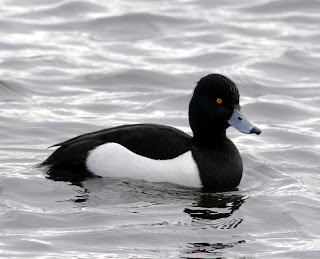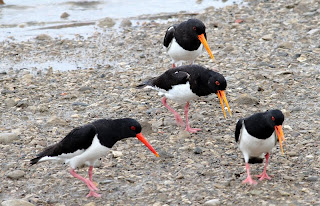I had an appointment in Fleetwood this morning so first nipped into a few of the well-worn birding spots. My first point of call was Rossall, most of which is actually part of Fleetwood, but I know from experience that some residents of the Rossall area consider they live in a more upmarket place than the very historic but perhaps not scenic port of Fleetwood. When asked, or in conversation they invariably say they live in Rossall. It’s comical really.
I set off towards Rossall Point just as a shower broke. Fortunately the coastguard tower was handy to hide in the lee of the burst, close against the wall so I didn’t get too wet.
Two Grey Seals popped out of the water, heading into the estuary or even the docks as they do occasionally. The sky brightened so heading west I scanned the shore. Wader numbers were thin with 1 Dunlin, 4 Turnstone and 3 Sanderling, their numbers swelled by 19 early returning Ringed Plover, and separate to them but between two other groynes, an adult performing a distraction display, but leading me in the direction I was already going. A fly past of 18 Dunlin and a single Whimbrel improved my counts. The Dunlin were all returning adults as we expect at this time of year. Carrion Crows hung about the beach and I couldn’t help but worry about the Ringed Plover chicks vulnerable to the corvid’s voracity and perseverance. But it’s not often a crow gets featured here,



The outgoing golfers disturbed four Sklarks from the fairway, whilst close to me Swallows were clearly on the move, not stopping and not many of them, but I counted 3 groups totalling 16 birds heading quickly south over the beach or above the dunes to then follow the River Wyre. Four Swifts low from the same direction as the Swallows also headed over the beach before disappearing in the same direction. Well it is almost August! 4 Pied Wagtails arrived on the beach but they too headed off towards the port. The tide was running in a little which probably helped the appearance of 6 Sandwich Terns, but the grey cloud didn’t help my photography today and the tide too low to concentrate the few waders.
I did my errand then made my way to Fleetwood Marsh Nature Park and parked up to watch a Song Thrush demolish a snail. It threatened rain again but on the pools were 42 Coot, 7 Tufted Duck and 9 Little Grebe including 3 fairly recent chicks, but all kept their distance as Little Grebes are wont to do. Waders on the “tyre pool” were 1 Lapwing, 2 Oystercatchers and a lone Black-tailed Godwit that stood around for a minute or two only before the large gulls came in from the docks to bathe and roost.




I counted 8 Swifts and 7 House Martins hawking over the “bridge pools” with 2 more Pied Wagtails and a Reed Warbler around the margins. I ventured towards the ringing area without exploring too deeply but on the passerine front I found 2 Sedge Warblers, 3 Reed Warblers, 2 Whitethroat, a Reed Bunting and 4 Skylarks.

I didn’t get wet after all. The rain stayed away with no need for a Barbour or a Fleetwood Mac.









































































